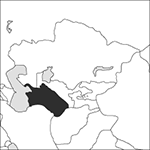
Source: MAPS IN MINUTES™ © RH Publications (1997)
Capital:
Ashgabat
Area:
488,100 sq km (186,400 sq miles)
Population:
4,833,000 (2005)
Currency:
1 manat = 100 tennesi
Religions:
Muslim 89.0%; Eastern Orthodox 9.0%
Ethnic Groups:
Turkmen 85.0%; Uzbek 5.0%; Russian 4.0%
Languages:
Turkmen (official); Russian; Uzbek; minority languages
International Organizations:
UN; OSCE; Commonwealth of Independent States; Euro‐Atlantic Partnership Council; Non‐Aligned Movement
A country lying east of the Caspian Sea and north of Iran.
Physical
Turkmenistan is in an arid region; it contains the greater part of the Kara Kum desert, which has important mineral resources. The oases produce cotton and mulberry trees (for silkworms), while livestock roam the semi‐desert areas. Oil and natural gas are found in the west, on the Caspian coastal plain.
Economy
Turkmenistan has the world's fourth largest reserves of natural gas, and principal export industries include gas (three-quarters of total exports, with China the most important pipeline destination), crude oil, and petrochemicals. Agriculture employs almost half the workforce; the principal export crop is cotton, and wheat and melons are also grown.
History
Turkmen never experienced political unity until conquered by the Russians in 1869. Even then fierce resistance lasted until 1881, and there was a rebellion in 1916. In 1918 a Social Revolutionary Transcaspian Republic was proclaimed. It was briefly supported by British troops until April 1919, after which it was conquered by the Red Army. In 1924 the Turkmen Soviet Socialist Republic was formed, and incorporated into the Soviet Union in 1925. It declared its sovereignty in August 1990 and its independence in October 1991. Turkmenistan joined the Commonwealth of Independent States (CIS) in 1991. A new constitution in March 1992 increased the powers of its executive President Saparmuradi Niyazov, and allowed only ethnic Turkmen to work in state enterprises. The extension of President Niyazov’s term of office was approved in a referendum in 1994, and in 1999 Niyazov became President for life. All seats in the legislative elections later that year were won by the former communists, renamed the Turkmen Democratic Party. The elections of 1999 and 2004 produced the same result. Niyazov died in 2006 and was succeeded by Gurbanguly Berdimuhammedov as Acting President. He won presidential elections held in 2007 and was re-elected in 2012, and 2017, (in the latter case with 97% of the vote). Although he has dismantled the personality cult linked to his predecessor, he controls the country just as tightly.